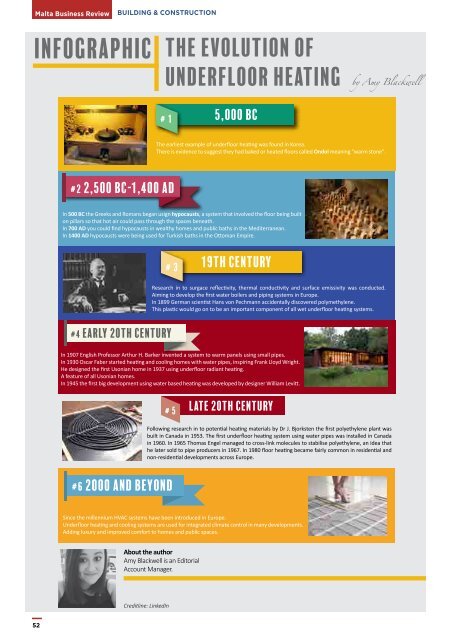PG ALL LR
Create successful ePaper yourself
Turn your PDF publications into a flip-book with our unique Google optimized e-Paper software.
Malta Business Review<br />
BUILDING & CONSTRUCTION<br />
CLIMATE CHANGE<br />
Malta Business Review<br />
INFOGRAPHIC<br />
The Evolution of<br />
Underfloor Heating<br />
# 1<br />
#2 2,500 BC-1,400 ad<br />
5,000 BC<br />
by Amy Blackwell<br />
The earliest example of underfloor heating was found in Korea.<br />
There is evidence to suggest they had baked or heated floors called Ondol meaning "warm stone".<br />
In 500 BC the Greeks and Romans began usign hypocausts, a system that involved the floor being built<br />
on pillars so that hot air could pass through the spaces beneath.<br />
In 700 AD you could find hypocausts in wealthy homes and public baths in the Mediterranean.<br />
In 1400 AD hypocausts were being used for Turkish baths in the Ottoman Empire.<br />
# 3<br />
#4 early 20th century<br />
19th century<br />
Research in to surgace reflectivity, thermal conductivity and surface emissivity was conducted.<br />
Aiming to develop the first water boilers and piping systems in Europe.<br />
In 1899 German scientist Hans von Pechmann accidentally discovered polymethylene.<br />
This plastic would go on to be an important component of all wet underfloor heating systems.<br />
European Parliament's President Antonio Tajani<br />
European Parliament's President Antonio<br />
Tajani reacted to the announcement by U.S.<br />
President Donald J. Trump to withdraw from<br />
the Paris Agreement on climate change.<br />
“Pacta sunt servanda. The Paris Agreement<br />
must be respected. It is a matter of trust<br />
and leadership” said European Parliament<br />
President Antonio Tajani (EPP, IT). "This<br />
Agreement is alive and we will take it forward<br />
with or without the US administration" he<br />
said.<br />
"Those who choose to remain on the outside<br />
will miss a historic opportunity for citizens, the<br />
EP President Tajani: “the Paris agreement<br />
is alive and we will take it forward”<br />
planet and the economy. The EU will continue<br />
to lead efforts against climate change and<br />
be a global pole of attraction for investment,<br />
innovation and technology, creating new jobs<br />
and boosting competitiveness" he added.<br />
Environment Committee Chair Adina-<br />
Ioana Vălean (EPP, RO) also reacted to the<br />
announcement: "We deeply regret this<br />
decision, and hope that this is only ‘see<br />
you soon’ and not ‘farewell’ from our U.S.<br />
friends", said Ms. Vălean. "To ease the<br />
transition to a low-carbon economy is simply<br />
to be pragmatic. The global community is<br />
committed to the Paris Agreement. Civil<br />
society, industry and public awareness have<br />
evolved. The United States still shares our<br />
planet, and we are entitled to hope that,<br />
beyond the decision of just one man – even<br />
if he is the President of the United States –<br />
America will, in the end, come back on our<br />
side in the fight against climate change”, she<br />
added.<br />
“In the meantime, we shall continue<br />
leading, together with China and the High<br />
Ambition Coalition. What is more, given the<br />
threat of global warming, this is a fight for<br />
multilateralism, for international cooperation,<br />
and for peace. And for we Europeans, an<br />
existential one", she concluded.<br />
Facts<br />
The European Parliament is currently<br />
working on three legislative measures<br />
implementing the Paris Agreement: the<br />
post-2020 carbon market (EU ETS) reform<br />
(rapporteur Julie Girling), the 2030 targets<br />
Effort Sharing Regulation (rapporteur<br />
Gerben-Jan Gerbrandy) and the Regulation<br />
on greenhouse gas emissions and removals<br />
from land-use, land-use change and forestry<br />
(rapporteur Norbert Lins). MBR<br />
In 1907 English Professor Arthur H. Barker invented a system to warm panels using small pipes.<br />
In 1930 Oscar Faber started heating and cooling homes with water pipes, inspiring Frank Lloyd Wright.<br />
He designed the first Usonian home in 1937 using underfloor radiant heating.<br />
A feature of all Usonian homes.<br />
In 1945 the first big development using water based heating was developed by designer William Levitt.<br />
# 5<br />
lATE 20TH CENTURY<br />
Following research in to potential heating materials by Dr J. Bjorksten the first polyethylene plant was<br />
built in Canada in 1953. The first underfloor heating system using water pipes was installed in Canada<br />
in 1960. In 1965 Thomas Engel managed to cross-link molecules to stabilise polyethylene, an idea that<br />
he later sold to pipe producers in 1967. In 1980 floor heating became fairly common in residential and<br />
non-residential developments across Europe.<br />
#6 2000 and beyond<br />
Since the millennium HVAC systems have been introduced in Europe.<br />
Underfloor heating and cooling systems are used for integrated climate control in many developments.<br />
Adding luxury and improved comfort to homes and public spaces.<br />
About the author<br />
Amy Blackwell is an Editorial<br />
Account Manager.<br />
Creditline: LinkedIn<br />
52 53<br />
www.maltabusinessreview.net

















